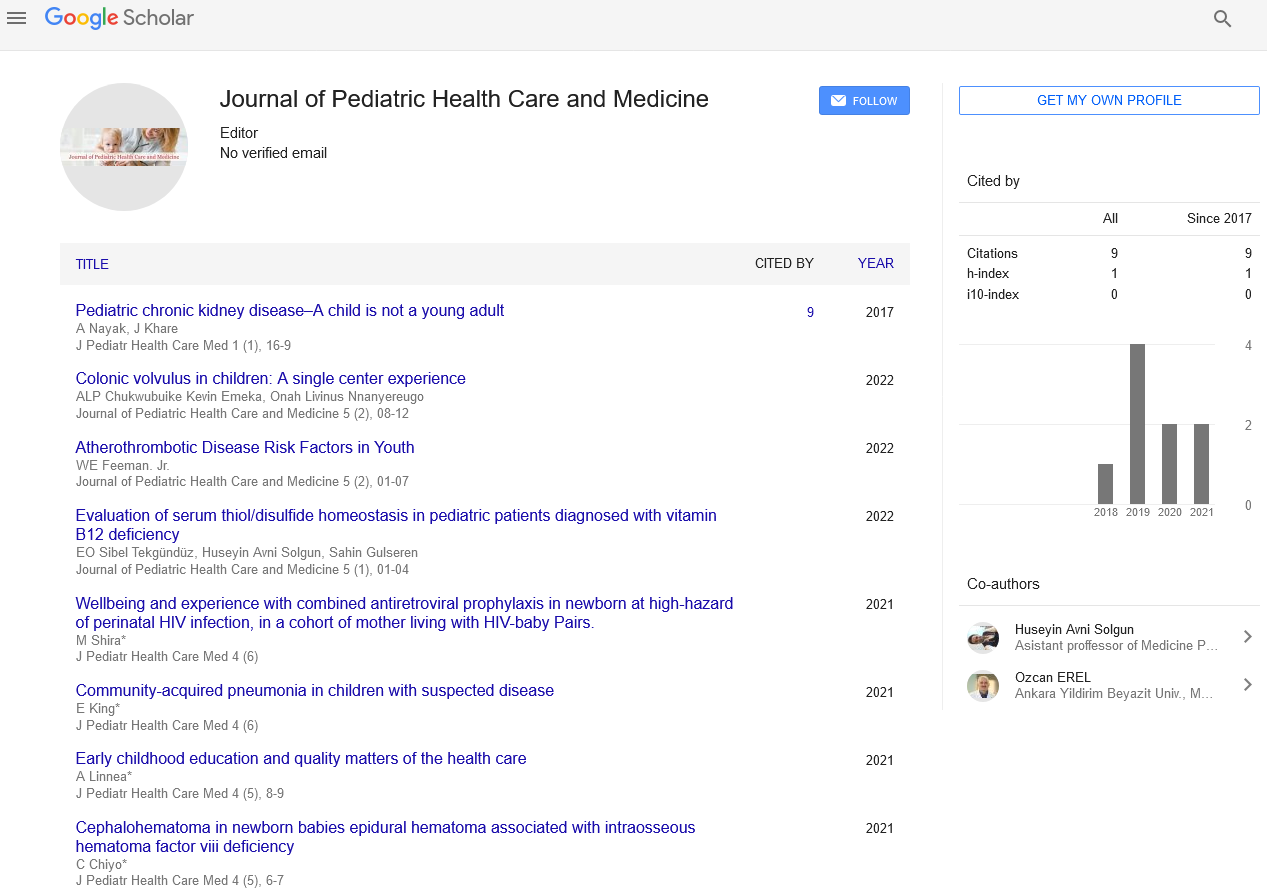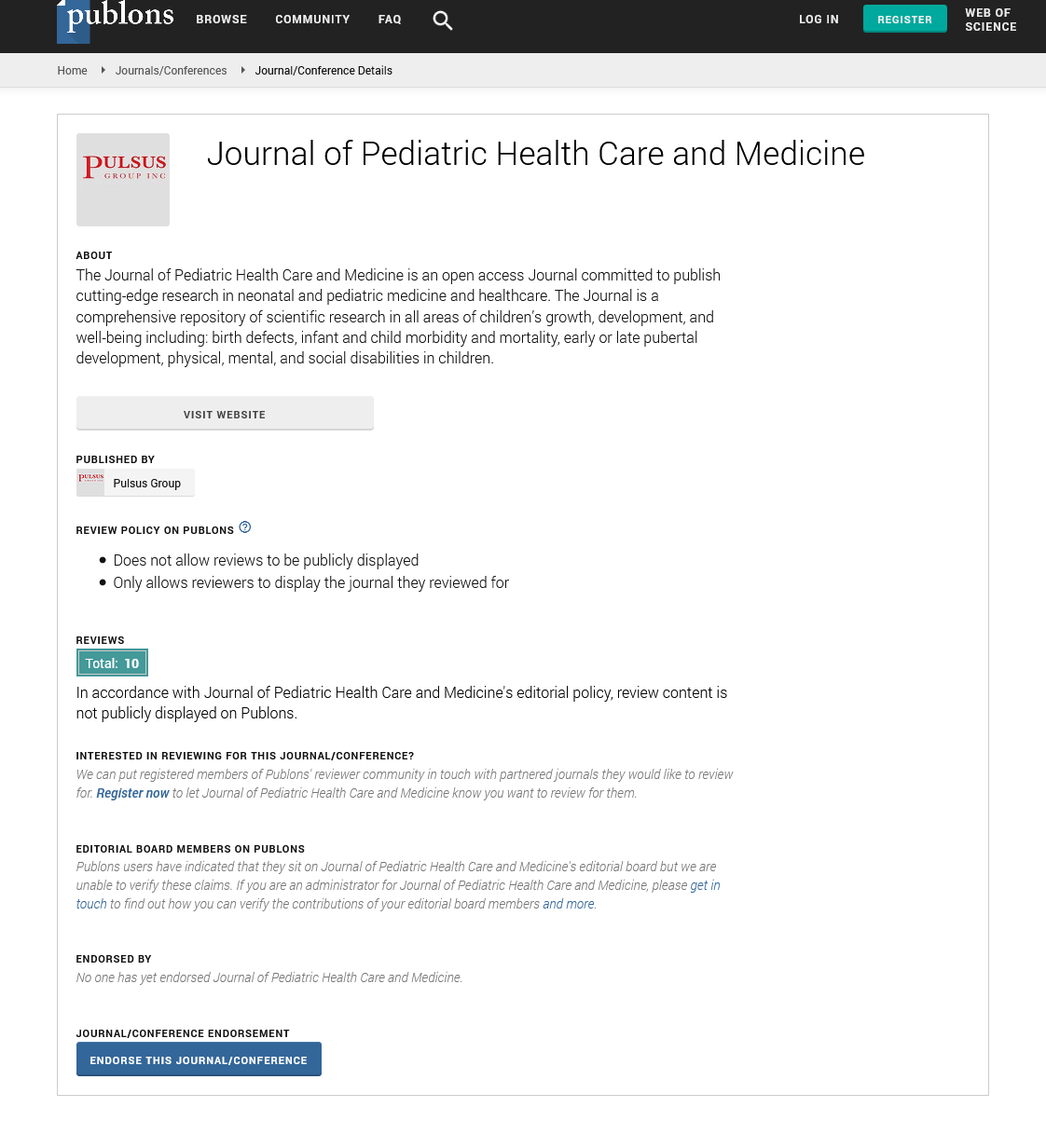Robotic Surgery in Pediatric
#Equally contribution
Received: 13-Apr-2021 Accepted Date: Apr 29, 2021; Published: 10-May-2021
Citation: Prasanna Laxmi Katekolla, Department of Pharmacology, Osmania University, Hyderabad, India, e-mail prasanna.k@gmail.com
This open-access article is distributed under the terms of the Creative Commons Attribution Non-Commercial License (CC BY-NC) (http://creativecommons.org/licenses/by-nc/4.0/), which permits reuse, distribution and reproduction of the article, provided that the original work is properly cited and the reuse is restricted to noncommercial purposes. For commercial reuse, contact reprints@pulsus.com
Abstract
Pediatric automated helped a medical procedure is expanding in pervasiveness. Patient size is a thought in determination for mechanical helped a medical procedure, however little size, less than 10 kg, isn't really a contraindication, contingent upon the particular patient and strategy. Operative achievement rates and difficulties of pediatric mechanical helped a medical procedure appear to be like those seen with laparoscopic medical procedure. Short expectations to absorb information for automated helped a medical procedure takes into account speedy execution of this innovation into a specialist's training.
Abstact
Pediatric automated helped a medical procedure is expanding in pervasiveness. Patient size is a thought in determination for mechanical helped a medical procedure, however little size, less than 10 kg, isn't really a contraindication, contingent upon the particular patient and strategy. Operative achievement rates and difficulties of pediatric mechanical helped a medical procedure appear to be like those seen with laparoscopic medical procedure. Short expectations to absorb information for automated helped a medical procedure takes into account speedy execution of this innovation into a specialist's training
Keywords
Pediatric automated; Patient size
Introduction
The originally depicted utilization of automated a medical procedure in a kid happened in 2001, almost 10 years after its utilization was first depicted in quite a while, with a case report portraying the utilization of this innovation in the production of a Nissen fundoplication. Since these underlying reports, automated a medical procedure has seen far reaching application inside the grown-up populace, particularly in urologic and gynecologic procedures.3,4 As is regularly the situation for new gadgets, innovation, and restorative alternatives in medical procedure, the utilization of automated a medical procedure for youngsters has happened more gradually than in grown-ups.
This alert is to a great extent because of specialized restrictions with growing fittingly estimated instrument for the pediatric patient; notwithstanding, late years have seen more extensive implementation.4,6 As another field, pediatric automated a medical procedure has had in excess of 200 articles distributed since its approach in 2001.4 most of this work has zeroed in on the turn of events of mechanical pediatric urology with a case volume expanding a normal of 236.6% per year.7 subsequently, the most wellknown systems portrayed utilizing mechanical technology are pyeloplasty and ureteral implantation, trailed by fundoplication in the pediatric general medical procedure literature.4,7
By 2012, 2393 automated strategies in 1840 pediatric patients were announced in the writing, and of these 36.8% are gastrointestinal procedures.8 Over time, more mind boggling and a more extensive assortment of cases are being portrayed utilizing an automated approach, including thoracic cases, Kasai portoenterostomies, and extraction of choledochal cysts.8
Albeit the careful advanced mechanics commercial center is developing, presently the lone advanced mechanics framework that is supported for pediatric use is framework was the main automated a medical procedure framework to be endorsed by the US Food and Drug Administration for intra-stomach a medical procedure and is the overwhelming mechanical medical procedure stage utilized in the United States.5,6,9,10 However, the solitary accessible instrument sizes on the da Vinci framework are 5 mm and 8 mm, along these lines restricting the capacity of this framework to be utilized in youngsters and little kids.
Comprehensively, the upsides of automated a medical procedure incorporate a considerable lot of similar specialized upgrades and advantages to patient recuperation as laparoscopic medical procedure and other negligibly intrusive methods that preceded it, including limiting employable injury, diminishing postoperative agony, restricting the requirement for postoperative narcotic use, diminishing clinic stays, a speedier revisitation of work or school, and improving restorative outcomes.
Supporters of mechanical medical procedure contend that it supplants the capacities of conventional laparoscopy by the actual idea of its plan. The essential burden of mechanical careful innovation in pediatric medical procedure is connected to the size of the careful robot and its related instruments (Table 1).5,6,10 As referenced, automated instruments endorsed for pediatric use are just accessible in 2 sizes—8 mm and 5 mm—which are both fundamentally bigger than the 3-mm instruments that are regularly utilized in customary laparoscopic methodology. Additionally, automated endoscopes are presently just accessible as 12.0 mm and 8.5 mm, as a already accessible 5-mm degree was stopped inferable from low use.5 Although the 8.5-mm degree might be useable in bigger kids, this size would be restrictively huge for the intercostal space of a youngster gauging 5 kg or less.15 Along these lines, the producer of the da Vinci careful stage suggests situation of ports 8 cm separated. This distance would be hard to accomplish in little youngsters or children where anatomic space is restricted.
Conclusion
Mechanical helped a medical procedure is protected and viable in kids and is consistently expanding in its utilization across pediatric medical procedure subspecialties. The collection of strategies that can be performed mechanically keeps on extending, remembering methodology for more youthful kids, newborn children, and youngsters.
Notwithstanding, more vigorous forthcoming examinations are required in pediatric automated helped a medical procedure to genuinely evaluate the advantages of utilizing this methodology instead of customary open or laparoscopic methods. One of the essential limits to the execution of mechanical technology in pediatric medical procedure explicitly is the accessibility of fittingly estimated instruments for the pediatric body habitus. As more modest automated instruments and endoscopes become industrially accessible utilization of mechanical medical procedure in youngsters will without a doubt increment.
REFERENCES
- 1. Meininger DD, Byhahn C, Heller K, et al. Totally endoscopic Nissen fundoplication with a robotic system in a child. Surg Endosc 2001.
- 2. Petralia P. Pediatric robotic surgery. 1st edition. In: Mattioli G, Petralia P, editors. Pediatric Robotic Surgery. 1st ed. Cham, Switzerland: Springer International Publishing; 2017: 1–188.
- 3. Mattioli G, Pini Prato A, Razore B, et al. Da Vinci robotic surgery in a pediatric hospital. J Laparoendosc Adv Surg Tech 2017;27(5):539–45.
- 4. Fernandez N, Farhat WA. A comprehensive analysis of robot-assisted surgery uptake in the pediatric surgical discipline. Front Surg 2019;6:1–8.
- 5. Bruns NE, Soldes OS, Ponsky TA. Robotic surgery may not “make the cut” in pediatrics. Front Pediatr 2015;3






